

Our Blogs
Our Latest Blogs
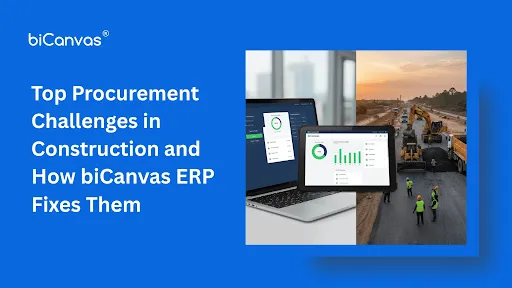
Top Procurement Challenges in Construction and How biCanvas ERP Fixes Them
In road construction or ready-mix concrete (RMC) production, timing is very crucial. If construction site materials, such as cement, aggregates, bitumen, or steel, are not procured within the scheduled time, workers will sit idle, and the work will not be completed by the fixed deadline. At the same time, overstocking materials affects your cash flow and creates clutter on the premises. Does that sound familiar?
Material procurement is one of the most important and complex functions in a construction project. With the biCanvas ERP software, you can bring transparency and efficiency to the entire procurement cycle.
Let's explore how biCanvas ERP helps construction companies to optimize material procurement throughout the entire process.
The Procurement Problem in Construction
In industries like road building and RMC, procurement is not merely about purchasing a product, but it's about buying smart at a scheduled time with your project timeline.
Here are some common challenges we have seen among construction companies:
-
Site engineers manually request materials without planning.
-
Procurement teams working in silos, without visibility into project timelines
-
Vendor delays or mismatches between delivered quantities
-
No correlation between purchase orders and actual project budgets
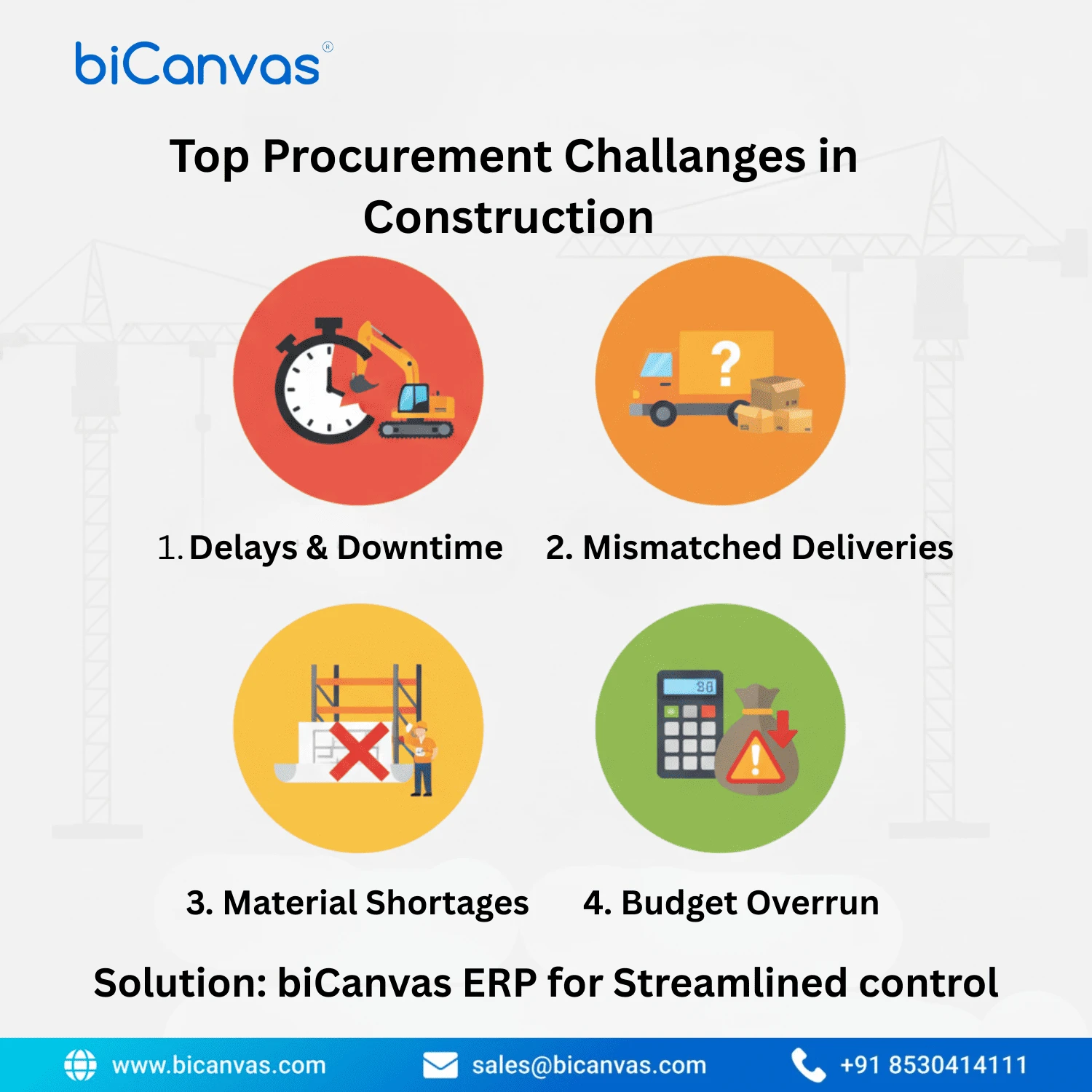
This results in cost overruns, delays, and unnecessary firefighting. That’s where biCanvas ERP steps in—designed specifically to handle these industry pains.
How biCanvas Optimizes Procurement (With Real-World Construction Use Cases)
1. Integrated Material Planning
biCanvas ERP software manages material procurement planning as per the project requirements. Whether you're constructing a highway foundation or batching concrete to build a bridge deck, biCanvas ERP always traces material requirements to each stage of the project.
Example: For a 10-km road stretch, the ERP system forecasts aggregate, bitumen, and binding agent requirements based on project timelines and automatically triggers alerts for future needs.
2. Easy, Trackable Material Requests from Site
Conveying information and work details through messages or using spreadsheets is now outdated. Site workers initiate material requests on mobile-friendly interfaces. Each request is assigned to a particular project, milestone, and location.
Example: Your batching plant operator orders 20 tons of cement for the next day’s pour. The order goes straight to the central procurement team through biCanvas ERP, complete with urgency status and stock checks.
Simplify-and-Track-Material-Requests-from-Site-with-Ease
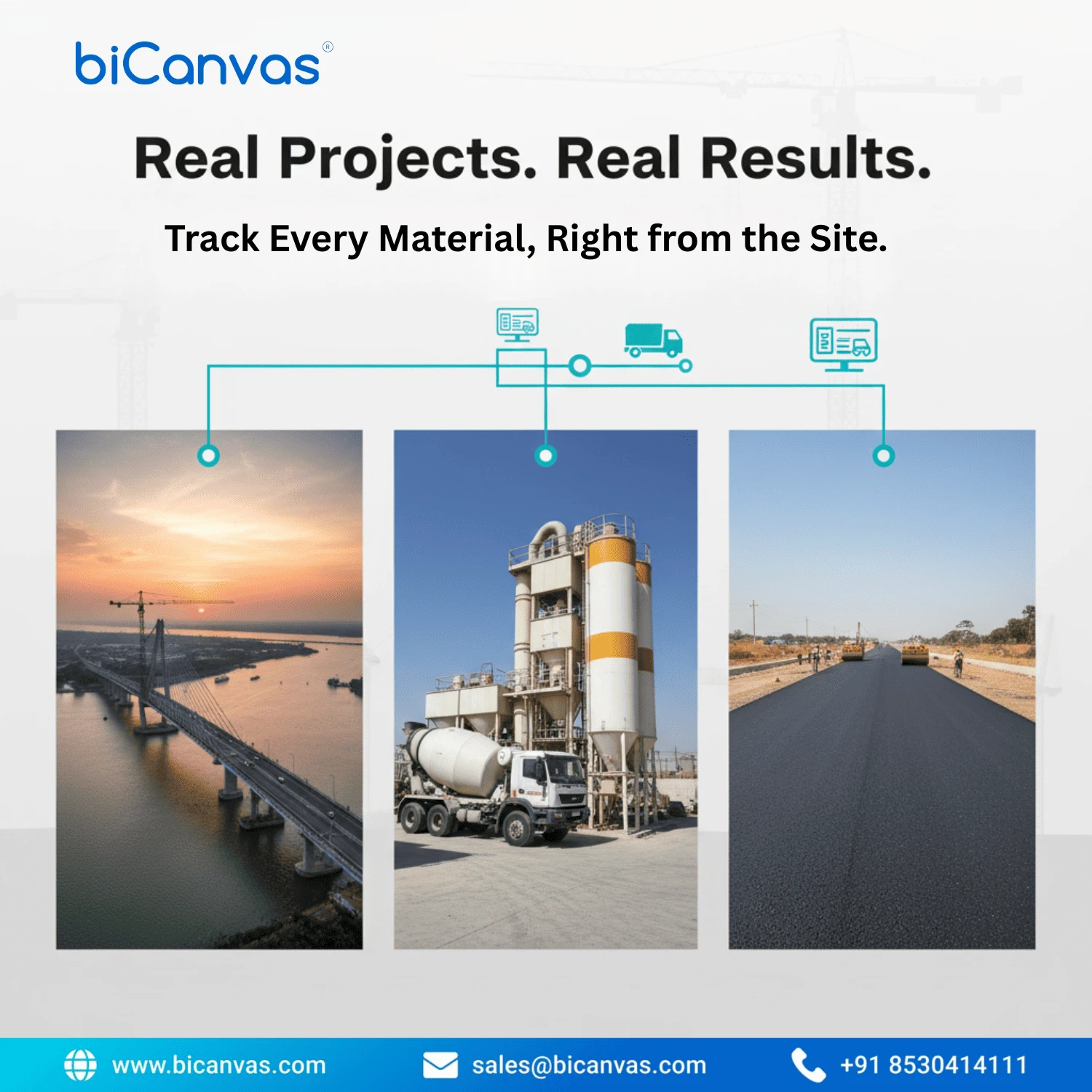
3. Smart Vendor Management and RFQ Comparison
biCanvas stores all your vendor data about past performance, rates, and delivery reliability, and allows you to send RFQs to multiple vendors with a click. You can easily compare prices, lead times, and quality scores before issuing a PO.
Example: If you have urgent requirements for bitumen, biCanvas compares Vendor A, which has the fastest delivery record, even if Vendor B is cheaper. Not only is it based on guesswork, but with the help of this real data, you can decide to buy material from the right vendor.
4. Real-Time PO and Delivery Tracking
The moment a PO is released, biCanvas follows each step, like dispatch status, transit time, and Goods Receipt Notes (GRNs). Delays or short deliveries automatically trigger an alert.
Example: A purchase order (PO) for crushed stone shows a 3-day delivery delay. biCanvas shows the delays and notifies the project manager so they can adjust the work schedule.
5. Store & Yard Management Without the Clutter
Each time you receive materials, they are automatically updated in real time. The stock is monitored based on its type, location, and usage. You even receive alerts if stock is idle or about to expire.
Example: If you are holding 50 MT of steel at your site that is not utilized or moved in 30 days, then biCanvas ERP suggests reusing or relocating it to another project or delaying new orders.
smart-Inventory-Management-with-biCanvas-ERP
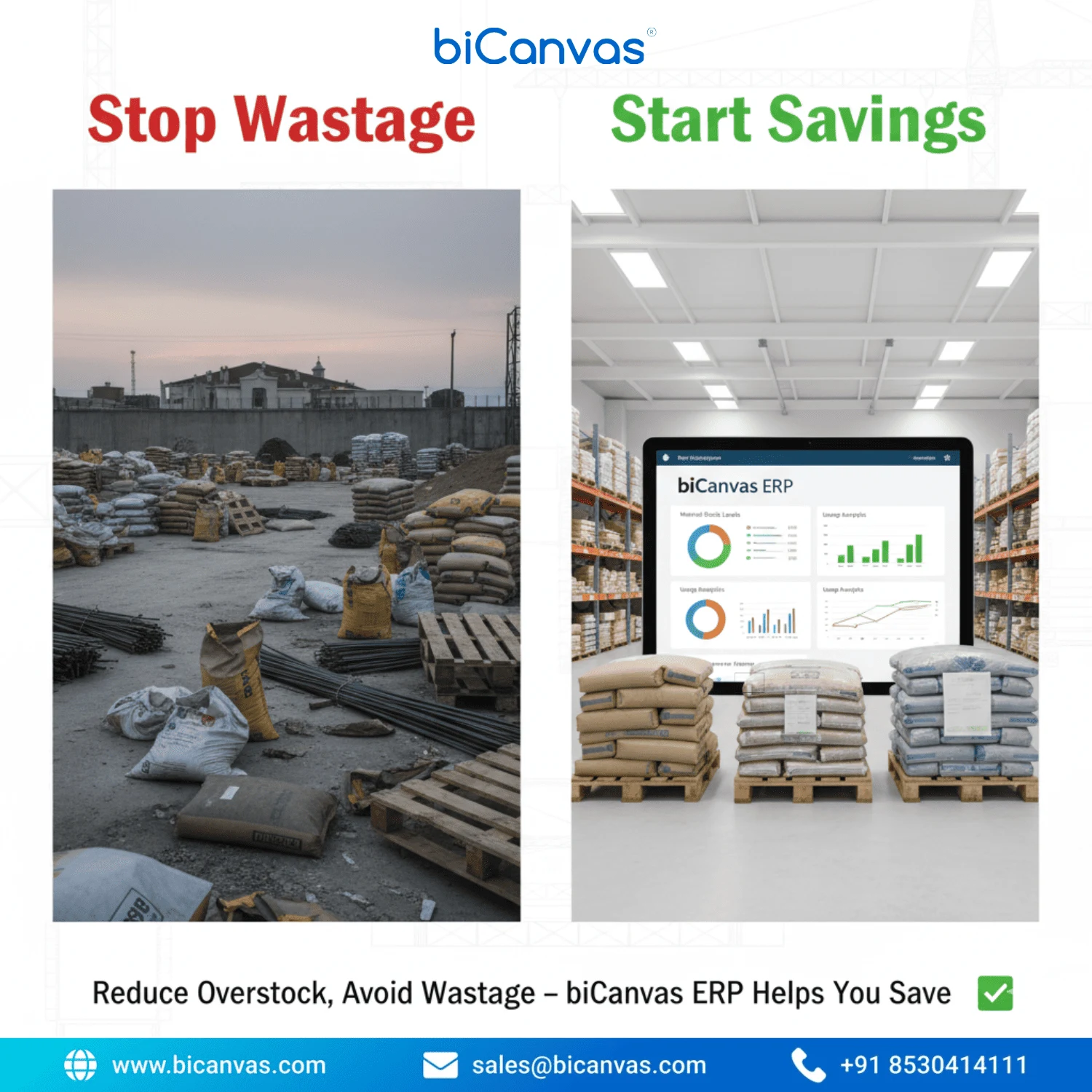
6. Budget and Cost Control Built-In
Every procurement activity is directly connected with the project budget that can be tracked with the help of biCanvas ERP. You can see how much you’ve committed vs. what you have spent down to each material line item. You can monitor the committed vs. spent on each item.
Example: In an RMC project, you notice cement consumption is going 10% over budget. biCanvas enables you to track the problem—was it overuse, wastage, or a price hike?
7. Accounts and Payments—No More Reconciliation Headaches
The good-receipt note (GRN) is automatically posted into the finance module when you have received goods. The program then attaches this to the support invoice and payment schedule, ensuring that suppliers are paid on time without the need for manual chasing.
Example: Diesel delivery receipts from the supplier are compared against GPS-logged diesel receipts on site, ensuring accuracy and audit visibility.
Why Construction Teams Love biCanvas
-
Designed for construction workflows
-
Mobile-friendly for field teams
-
Real-time dashboards for procurement heads and project managers
-
Custom alerts for material delays, stockouts, and PO deviations
-
Seamless integration with project schedules, finance, and inventory
Conclusion
In construction, the cost of poor procurement extends beyond financial to operational consequences. Each lost hour waiting for materials delays your whole project. With biCanvas ERP, you gain control, visibility, and efficiency across your procurement cycle. It's not a matter of digitizing what you're doing already. It's about getting it done better, quicker, and smarter.
Our Blogs
Our Latest Blogs

Top Procurement Challenges in Construction and How biCanvas ERP Fixes Them
In road construction or ready-mix concrete (RMC) production, timing is very crucial. If construction site materials, such as cement, aggregates, bitumen, or steel, are not procured within the scheduled time, workers will sit idle, and the work will not be completed by the fixed deadline. At the same time, overstocking materials affects your cash flow and creates clutter on the premises. Does that sound familiar?
Material procurement is one of the most important and complex functions in a construction project. With the biCanvas ERP software, you can bring transparency and efficiency to the entire procurement cycle.
Let's explore how biCanvas ERP helps construction companies to optimize material procurement throughout the entire process.
The Procurement Problem in Construction
In industries like road building and RMC, procurement is not merely about purchasing a product, but it's about buying smart at a scheduled time with your project timeline.
Here are some common challenges we have seen among construction companies:
-
Site engineers manually request materials without planning.
-
Procurement teams working in silos, without visibility into project timelines
-
Vendor delays or mismatches between delivered quantities
-
No correlation between purchase orders and actual project budgets

This results in cost overruns, delays, and unnecessary firefighting. That’s where biCanvas ERP steps in—designed specifically to handle these industry pains.
How biCanvas Optimizes Procurement (With Real-World Construction Use Cases)
1. Integrated Material Planning
biCanvas ERP software manages material procurement planning as per the project requirements. Whether you're constructing a highway foundation or batching concrete to build a bridge deck, biCanvas ERP always traces material requirements to each stage of the project.
Example: For a 10-km road stretch, the ERP system forecasts aggregate, bitumen, and binding agent requirements based on project timelines and automatically triggers alerts for future needs.
2. Easy, Trackable Material Requests from Site
Conveying information and work details through messages or using spreadsheets is now outdated. Site workers initiate material requests on mobile-friendly interfaces. Each request is assigned to a particular project, milestone, and location.
Example: Your batching plant operator orders 20 tons of cement for the next day’s pour. The order goes straight to the central procurement team through biCanvas ERP, complete with urgency status and stock checks.
Simplify-and-Track-Material-Requests-from-Site-with-Ease

3. Smart Vendor Management and RFQ Comparison
biCanvas stores all your vendor data about past performance, rates, and delivery reliability, and allows you to send RFQs to multiple vendors with a click. You can easily compare prices, lead times, and quality scores before issuing a PO.
Example: If you have urgent requirements for bitumen, biCanvas compares Vendor A, which has the fastest delivery record, even if Vendor B is cheaper. Not only is it based on guesswork, but with the help of this real data, you can decide to buy material from the right vendor.
4. Real-Time PO and Delivery Tracking
The moment a PO is released, biCanvas follows each step, like dispatch status, transit time, and Goods Receipt Notes (GRNs). Delays or short deliveries automatically trigger an alert.
Example: A purchase order (PO) for crushed stone shows a 3-day delivery delay. biCanvas shows the delays and notifies the project manager so they can adjust the work schedule.
5. Store & Yard Management Without the Clutter
Each time you receive materials, they are automatically updated in real time. The stock is monitored based on its type, location, and usage. You even receive alerts if stock is idle or about to expire.
Example: If you are holding 50 MT of steel at your site that is not utilized or moved in 30 days, then biCanvas ERP suggests reusing or relocating it to another project or delaying new orders.
smart-Inventory-Management-with-biCanvas-ERP

6. Budget and Cost Control Built-In
Every procurement activity is directly connected with the project budget that can be tracked with the help of biCanvas ERP. You can see how much you’ve committed vs. what you have spent down to each material line item. You can monitor the committed vs. spent on each item.
Example: In an RMC project, you notice cement consumption is going 10% over budget. biCanvas enables you to track the problem—was it overuse, wastage, or a price hike?
7. Accounts and Payments—No More Reconciliation Headaches
The good-receipt note (GRN) is automatically posted into the finance module when you have received goods. The program then attaches this to the support invoice and payment schedule, ensuring that suppliers are paid on time without the need for manual chasing.
Example: Diesel delivery receipts from the supplier are compared against GPS-logged diesel receipts on site, ensuring accuracy and audit visibility.
Why Construction Teams Love biCanvas
-
Designed for construction workflows
-
Mobile-friendly for field teams
-
Real-time dashboards for procurement heads and project managers
-
Custom alerts for material delays, stockouts, and PO deviations
-
Seamless integration with project schedules, finance, and inventory
Conclusion
In construction, the cost of poor procurement extends beyond financial to operational consequences. Each lost hour waiting for materials delays your whole project. With biCanvas ERP, you gain control, visibility, and efficiency across your procurement cycle. It's not a matter of digitizing what you're doing already. It's about getting it done better, quicker, and smarter.
OUR BLOGS
Our Latest Blogs

ERP for the Contracting & Infrastructure Industry: A Simple Guide to Smarter Project Management
In today's fast-paced, dynamic world, attempting to manage large infrastructure and contracting projects without the proper tools risks issues, delays, and extra expenditures. Large infrastructure and contracting projects require teams that understand how to control costs, schedules, and resources. Traditional tools simply won't give you the visibility and control that can put you in contention. Enterprise Resource Planning (ERP) solutions can assist in this by providing you with one location to plan, execute, and continue monitoring your projects more wisely. This guide talks about how ERP simplifies project management for infrastructure corporations and contractors, which minimizes delays and cost overruns. Whether you're building bridges, roads, or city infrastructure, with the help of the right ERP, you can complete projects on schedule and on budget. Let's talk about how an ERP system may help you stay organized, make your life easier, and make more profit. What Is ERP? Enterprise resource planning (ERP) software consolidates all the fundamental functions of a business into a single system. It facilitates departments to share information and communicate more efficiently with each other, like HR, sales, inventory, and finance. ERP assists businesses in getting real-time information, automating tasks, and cutting down on mistakes brought on by humans. It improves decision-making, coordination, and production throughout the entire firm. Overall, ERP is the primary structure that simplifies business processes and keeps them organized. What is contracting in simple terms? Contracting is the activity of businesses or individuals working on engineering or building projects based on agreements or contracts. Contracting is the activity of businesses or individuals engaged in engineering or building projects guided by contracts or agreements. These contractors are responsible for completing projects like roads, bridges, buildings, water supply systems, and power plants. There are different types of contractors: General Contractors – who manage the whole project. Subcontractors – who handle specific parts like plumbing or electrical work. EPC Contractors – who are related to engineering, procurement, and construction. In infrastructure projects, contractor work is conducted under strict timeframes, large budgets, and multiple stakeholders. Why Contractors and Infrastructure Firms Need a Specialized ERP For daily operations, generic ERP systems are excellent. But infrastructure projects are quite distinct from one another. Projects run for several months or years. Multiple teams work on multiple sites. Budgets are rather large and strictly under control. Compliance, safety, and documentation are critical. This is where biCanvas ERP stands out. It’s tailored for the construction and infrastructure world, with features designed to manage the real-life situations you deal with every day. Imagine a single dashboard where you can: Track project progress. Manage materials and equipment. Control expenses. Handle subcontractor billing. Generate reports for clients and government bodies. That’s what ERP does—it centralizes everything, making your job easier and more accurate. Life Before ERP: The Chaos of Manual Project Management Before ERP, most contractors used: Excel sheets to track materials WhatsApp or email to communicate Work orders and invoices created on paper Separate software for accounting and payroll This caused: Data silos (no single source of truth) Delays due to poor communication Errors in cost estimations and billing Insufficient knowledge of real-time project conditions In short, teams worked hard but not smart. Smarter Project Management with ERP: The Transformation With ERP, everything is connected. Let’s look at how ERP transforms infrastructure project management: 1. Project Planning and Budgeting Set project milestones. Budget allocation by activity Plan resources (manpower, machinery, and materials). 2. Procurement and Inventory Control Raise purchase requests from the site. Approve POs from the Head Office. Track inventory across warehouses and sites. 3. Site Execution & Progress Tracking Log daily progress (DPR). Compare actual vs. planned work. Monitor labor and equipment usage. 4. Billing and Payments Generate RA (Running Account) bills for clients. Track subcontractor payments. Automate client invoicing based on BOQ. 5. Finance and Cost Management Monitor expenses in real time. Control overheads and leakages. Generate P&L reports by project. 6. HR and Payroll Manage site attendance via mobile device. Analyze allowances and overtime. Handle statutory compliance and payroll processing. Infrastructure Project Workflow with ERP—A Realistic View ERP helps control a road-building project through a simpler process, as follows: Phase 1: Project Initiation ERP project development within a budget BOQ (Bill of Quantities) uploaded The Work Breakdown Structure (WBS) is defined. Phase 2: Planning Schedule mapped in a Gantt chart Resources planned (materials, labor, equipment) Areas of risk highlighted Phase 3: Procurement The site raises a purchase request. HO approves and issues a Purchase Order (PO). GRN (Goods Received Note) logged on delivery Phase 4: Execution Daily logs updated by site engineers Digital tracking of subcontractor work Real-time stock and fuel usage are monitored. Phase 5: Billing Client bills are generated depending on reached benchmarks. Bills from subcontractors were verified, validated, and processed. Retention and progress under control Phase 6: Closure Final reconciliation of costs Review of project performance Reports generated for stakeholders Key Benefits of ERP for Contracting & Infrastructure Companies Real-Time Project Tracking- Know exactly what is happening on every site at any moment. From your dashboard, biCanvas ERP lets you track progress, costs, timelines, and risks. Smarter Budget & Cost Control- No more budget surprises. There are no more surprising budgets. Track real-time expenditure and get alerts when you approach limitations. Forecasting becomes easier, too. Field-to-Office Communication- Using ERP via a mobile application, the field team is capable of updating information, sending site pictures, requesting approval, or reporting about any incident directly to the office, which can be done from any remote area. Subcontractor & Contract Management- Easily manage contracts, monitor performance, automate billing milestones, and stay on the right side of the law. Tracking Material & Equipment- With ERP, you are able to track the location of items such as cement bags and heavy equipment, where they are being used, and where they require restocking. Faster, Safer Decision-Making—The leadership team can make decisions quickly and confidently using insights from the dashboard and analytics report. The leadership team is able to make decisions rapidly and with confidence due to the facts and insights provided from the dashboard and analytics report. Why biCanvas ERP Over Others? Although most ERP systems aim to accommodate every sector, BiCanvas is focused on infrastructure and construction. For this implies, Pre-built templates for site operations, work orders, RFIs, etc. Better visibility across large-scale or multi-location projects Built-in safety, compliance, and quality checks Easier onboarding for site engineers and contractors Conclusion Infrastructure and contracting companies deal with high-value, high-risk projects. Mistakes or delays can cost crores. ERP brings clarity, control, and confidence to project execution. ERP ensures every rupee and every hour counts, whether it is a road, a dam, or a metro line. It's time to move to smart project management with ERP if you still run initiatives on separate platforms or spreadsheets. With biCanvas ERP, you get a system that understands your industry inside and out. You save time, reduce waste, improve communication, and, most importantly, deliver projects on time and within budget. Ready to build smarter? It might be time to explore what biCanvas ERP can do for your team. Need guidance or a personalized demo of the right ERP for your infrastructure projects? Let’s discuss your workflows and see how technology can simplify your life.
OUR BLOGS
Our Latest Blogs

Streamline Supply Chain Management with a Unified ERP
In today's fast-paced world, dealing with multiple vendors, fluctuating demands, global shipping delays, and growing client expectations makes supply chain and logistics workflows more complex. If you're managing operations with spreadsheets, phone calls, and disconnected systems, it's a recipe for delays, stockouts, or unhappy customers. This is where a unified ERP system makes all the difference. Let’s walk through, in simple terms, how ERP simplifies and streamlines supply chain operations, helps you reduce expenses, avoid chaos, and stay ahead of the competition. What Is a Unified ERP? A unified ERP (Enterprise Resource Planning) system integrates purchasing, inventory, warehousing, production, sales, logistics, and finance into one single platform. You end up with a single source of truth for your entire supply chain instead of juggling four or five disconnected tools. What Happens When You Don’t Use ERP? Many companies still manage their supply chain manually or through fragmented systems. This causes problems like: Outdated inventory data Delayed approvals and miscommunication Missed or duplicate orders No visibility into supplier performance Inaccurate forecasting and stock imbalances If that sounds familiar, it's time to adopt a better solution—ERP. How ERP Streamlines Supply Chain Operations ERP helps manage the entire supply chain in one system, simplifying the ability to monitor orders, inventory, and deliveries. It improves supply chain collaboration and reduces delays by providing real-time updates to all departments. 1. Real-Time Inventory Management ERP automatically tracks inventory across warehouses, locations, and process stages. Benefits: Know exact stock availability in real time Receive alerts before running out or overstocking Auto-update inventory upon goods receipt or shipment No more stock surprises—just a smooth inventory flow. 2. Smarter Procurement Planning ERP helps you plan purchasing based on demand, supplier lead times, and past data. Benefits: Auto-generate POs by assessing stock levels Choose suppliers by price, delivery speed, or past performance Track order status and expected delivery dates This eliminates last-minute purchases and strengthens vendor relationships. 3. Seamless Vendor & Supplier Management ERP centralizes all vendor data, including contacts, contracts, delivery logs, and performance records. Benefits: Compare supplier quotes and turnaround times easily Track delays, rejections, or compliance issues Automate vendor communication and approval workflows Vendor visibility is critical to building resilient supply chains. 4. Demand Forecasting with Data ERP leverages real-time sales and trend data to make accurate predictions about future demand. Benefits: Procure or produce just the right quantity Cut down excess inventory and storage costs Be ready for seasonal spikes or emergency orders Forecasting becomes data-driven—not guesswork. 5. Faster Order Fulfillment Once a sales order is placed, ERP activates workflows across inventory, shipping, and billing. Benefits: Faster delivery from order to dispatch Fewer fulfillment errors All departments work in sync This results in happier customers and repeat business. 6. Unified Dashboard for Decision-Makers ERP gives you live dashboards and analytics to track performance metrics across the supply chain. Benefits: Detect issues early—before they escalate Track KPIs like fulfillment rates, supplier reliability, and cost per order Make quicker, smarter decisions No more waiting for reports—your insights are live. Why It Matters More Than Ever Recent global disruptions—from pandemics to shipping backlogs—have shown us how fragile supply chains can be. Businesses need flexible, data-driven systems to handle changes without breaking down. A unified ERP helps you: React faster to market or supply disruptions Stay productive across distributed teams and locations Scale operations without creating bottlenecks This is more than just software—it’s your strategy for building resilience and growth. Conclusion Trying to manage supply chains manually is like driving blind. It’s slow, risky, and stressful. A unified ERP gives you a clear view of your operations and puts you in control—from sourcing to delivery. If your team is still stuck chasing updates, struggling with inventory errors, or reacting to surprises, it’s time to upgrade. Ready to simplify your supply chain? Discover how biCanvas ERP can give you full visibility and control across sourcing, logistics, inventory, and finance. Book your free demo today!
OUR BLOGS
Our Latest Blogs
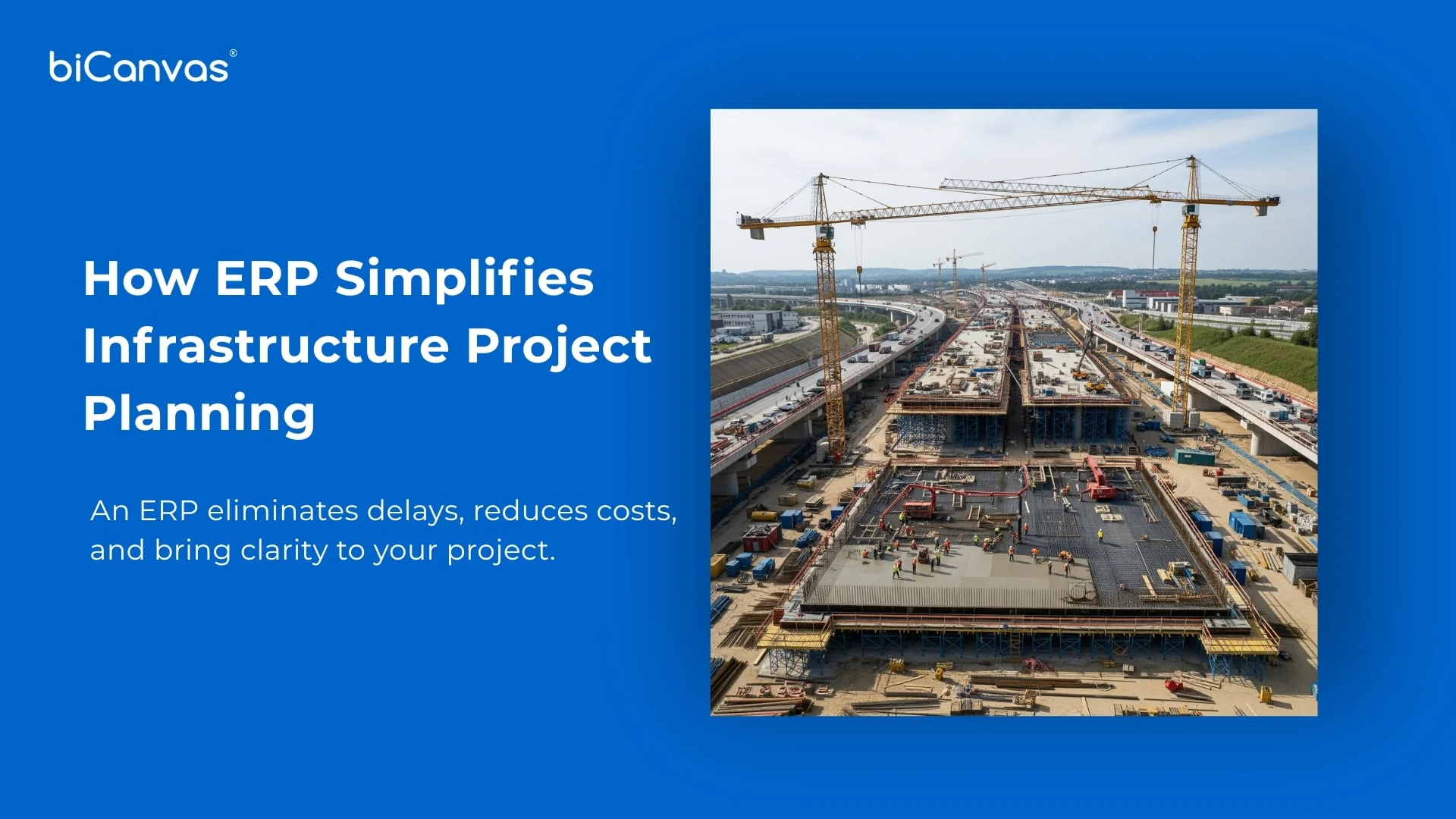
How ERP Simplifies Infrastructure Project Planning
Planning an infrastructure project is a tough task. Whether it’s a highway, metro rail system, bridge, or water treatment plant, these projects are large in scale, technically demanding, and often take several years to complete from initial planning to final execution, involving multiple phases. Things can quickly get chaotic when there are numerous contractors, tight budgets, heavy equipment, and fluctuating deadlines. That’s where ERP (Enterprise Resource Planning) steps in as a game-changer. ERP brings all your project data into one system, giving you real-time visibility into every aspect of the job. You can plan better, track progress, control costs, and avoid delays. It connects teams, automates routine tasks, and helps you make faster decisions with accurate information. With ERP, you spend less time putting out fires and more time building successfully. In this blog, let’s explore how ERP helps simplify and streamline infrastructure project planning. What is ERP? ERP is software that unifies all your business operations into a single integrated system, including project planning, finance, procurement, labor management, equipment tracking, compliance, and reporting. ERP provides a single platform where everything is connected and eliminates the need for spreadsheets, emails, and separate software for each department. The Struggle Behind Planning Infrastructure Without ERP You might be facing the following issues if you're handling infrastructure projects manually or using outdated tools: Scattered project data: Everyone uses different tools, and files are not synchronized. Delayed approvals: Procurement, design changes, or contractor payments get stuck in email threads. Lack of real-time tracking: Delays or overspending go unnoticed until it’s too late. Complex compliance: Hours are spent compiling records for government reporting or audits. Inaccurate forecasting: Poor data leads to budget overruns and resource mismanagement. 1. Centralized Project Planning ERP allows you to define budgets, assign tasks, set milestones, and develop comprehensive project plans all in one location. Benefits: Everyone follows the same strategy Clearly defined dependencies and work allocations Compare anticipated timelines with real-time progress Imagine your project managers, engineers, and finance team all looking at the same live dashboard — eliminating confusion or duplicated effort. 2. Seamless Procurement & Vendor Coordination ERP systems come with built-in procurement workflows for buying materials, hiring subcontractors, and managing vendors. Benefits: Create digital purchase orders and get fast approvals Track material deliveries across multiple sites Assign procurement expenses directly to specific projects Track every purchase and know exactly how much has been spent and received — no more overordering or lost receipts. 3. Budgeting, Forecasting, and Cost Control ERP tools allow you to set financial controls and track your spending at every stage of the infrastructure project. Benefits: Set budgets by project phase, task, or department Compare real-time spend with planned estimates Receive alerts when costs exceed budget No more end-of-month surprises — just proactive financial control. 4. Workforce and Equipment Planning Infrastructure requires a large workforce and heavy equipment. ERP helps in proper planning and utilization of both. Benefits: Organize labor by project phase Track equipment usage and maintenance schedules Avoid project delays caused by idle resources 5. Built-in Compliance and Reporting Public infrastructure projects are heavily regulated. ERP automates documentation and maintains audit trails for approvals and transactions. Benefits: Every transaction is digitally recorded Generate client or government reports with a few clicks Control access with role-based permissions 6. Real-Time Dashboards and Mobile Access Modern ERP systems offer live dashboards and mobile access, so your site and office teams stay aligned. Benefits: Instant project status updates Faster decisions, fewer delays Improved communication between locations Conclusion Infrastructure projects are complex — but managing them doesn’t have to be. With ERP, you don’t just digitize paperwork; you build a system for better planning, smoother execution, and stronger project outcomes. ERP helps you: Plan with clarity Execute with confidence Deliver on time and within budget If your current tools are slowing you down, it’s time to invest in an ERP solution that supports long-term growth and efficiency. Discover how a powerful ERP system can eliminate delays, reduce costs, and bring clarity to every phase of your project. Schedule a free demo today!
OUR BLOGS
Our Latest Blogs

Top 10 ERP Myths vs. Reality For Construction Businesses
In the construction and infrastructure industry, managing your budgets, resources, teams, and timelines is very crucial. This is where ERP (Enterprise Resource Planning) systems come into play. Unfortunately, due to widespread myths, most companies avoid adopting ERP systems. In this blog, we will look at the 10 most prominent ERP myths, revealing the truth behind them, especially for businesses in construction and infrastructure. Myth 1: ERP Systems Are Designed Exclusively for Big Companies Without Small Businesses in Consideration Reality: It is a common misconception that only big companies make use of ERP software. Modern construction ERP solutions are designed to fit small and medium-sized enterprises, too. Whether you are building roads, bridges, or even residential complexes, ERP can help you manage your projects as it efficiently integrates with your construction site, billing, procurement, and project management. Myth 2: ERP Is Too Expensive and Requires a Great Financial Investment Reality: Indeed, ERP requires investment, but it is something that is spent for future returns. The ROI in the long run makes covering upfront expenses worth it. By automating tasks like material tracking, subcontractor billing, and project costing, ERP reduces errors, delays, and budget overruns. biCanvas offers a cost-effective ERP for construction, delivering powerful tools without the high costs typically associated with enterprise software. Myth 3: ERP Systems Require a Long Time to Implement Reality: With industry-specific ERP solutions, implementation is faster and smoother. For instance, construction ERP software contains advanced features such as BOQ management, project scheduling, vendor portals, and more, which expedite the entire setup process. biCanvas ensures quick ERP implementation for construction without disrupting ongoing projects. Myth 4: ERP Is Too Complex to Use Reality: Today's ERP systems include mobile apps for field teams and user-friendly dashboards. Within a few hours of training, team members can manage purchase orders, monitor site materials, and generate reports. biCanvas simplifies complex project tasks with an intuitive interface made for both project managers and on-site workers. Myth 5: Excel Is Enough for All Project Management Tasks Reality: Excel is excellent for basic calculations, but it doesn’t offer real-time updates, automation, or integrated workflows. ERP gives complete visibility over multiple sites, enables real-time cost control, and unifies communication. Myth 6: ERP Won’t Fit My Construction Workflow Reality: ERP can be tailored to match your construction workflows, including tendering, subcontractor billing, equipment tracking, and compliance. biCanvas is a customizable ERP for infrastructure projects, offering modular features that adapt to your specific operations. Myth 7: ERP Only Helps with Accounting Reality: ERP software goes far beyond accounting. It supports site execution tracking, HR and payroll, inventory control, procurement, and compliance. biCanvas runs the full project lifecycle through one integrated platform. Myth 8: You Lose Control After ERP Implementation Reality: ERP gives you better control and real-time visibility. With automated alerts and live dashboards, nothing goes unnoticed. biCanvas helps you monitor costs, progress, and resources instantly across sites. Myth 9: ERP Systems Are Rigid and Inflexible Reality: Cloud-based ERP platforms today are modular and scalable. You can start small and add features as your business grows. biCanvas is flexible enough to serve contractors, builders, and large infrastructure developers alike. Myth 10: ERP Is a One-Time Setup — Then You're Done Reality: ERP implementation is the beginning of a continuous improvement journey. With training, updates, and feedback loops, your ERP grows with your business. biCanvas provides long-term support to ensure performance stays optimized. Conclusion: Don’t Let ERP Myths Hold You Back Implementation of ERP for construction and infrastructure projects helps in time management, cost-cutting, and boosting efficiency across the board. Don’t let outdated myths stop your company from building smarter and faster. biCanvas is a comprehensive ERP for construction companies, designed to manage everything from planning and budgeting to procurement and on-site execution — all in one system. Ready to explore how biCanvas ERP can simplify your construction business? Get in touch with us today.








